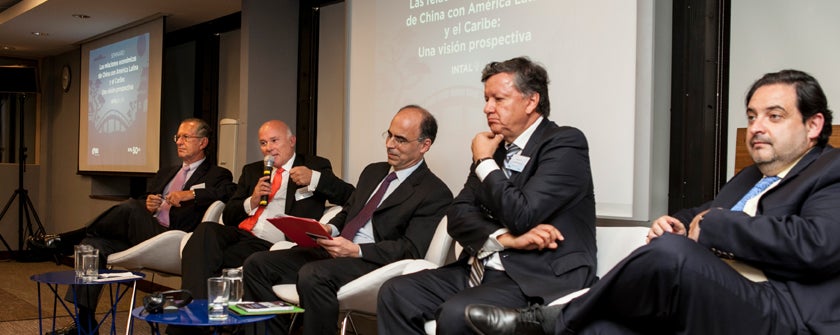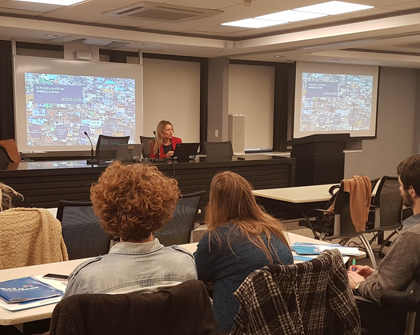The seminar entitled The economic relations between China and Latin America and the Caribbean: a prospective vision was attended by those heading the region’s trade negotiations with China. The agenda included a panel discussion with negotiators from Chile, Costa Rica, and Peru, the three countries in the region that have free trade agreements (FTAs) with China.
The panel was moderated by Mauricio Mesquita Moreira (IDB), and also included Renato Baumann (IPEA Brazil), who carried out a comparative analysis of eight FTAs between China and the following countries: ASEAN, New Zealand, Australia, Chile, Peru, Costa Rica, Korea, and Singapore. While in general FTAs have to do with geographical proximity, certification of origin, and exchange rate cooperation, those signed by China do not usually include these topics and are instead very pragmatic agreements with certain common themes: transparency, national treatment, customs procedures, reference to World Trade Organization (WTO) regulations, disciplines on government procurement, concurrency, and competition. However, there are major differences between the different agreements as these are all made to measure.
In addition, a learning curve can be observed: the newer agreements are more sophisticated and comprehensive than the older ones. They are different to the US and EU FTAs, which are a one-size-fits-all model that is either accepted or rejected, without the possibility of making adjustments. In this context, what lies ahead for LAC is a challenge—but also an opportunity.
Productive complementarity can be observed in the context of tariff preferences within Southeast Asia. In contrast, not only is the geography of LAC unhelpful in this regard, there is also less promotion of complementarity. Furthermore, when considering the PA and the MERCOSUR, it is important to note that Chile and Peru have already FTAs with China; and that Mexico, Chile, and Peru are in the TPP; which implies enormous challenges and competition for the MERCOSUR. Dr Baumann concluded by focusing on the need for clear national objectives without preconceptions at the negotiation table, and also discussed the problem of the MERCOSUR having no clear direction and not participating actively in any such negotiations.
The negotiators for LAC’s three FTAs with China shared the most important lessons they had learned from negotiating these agreements, stressing the particular aspects that distinguished this experience from that of negotiating with other countries.
Eduardo Ferreyros Kuppers (in Spanish) (former Minister of Foreign Trade and Tourism of Peru), highlighted the fact that Peru had sought to open itself up to the world, but that the population had been against an FTA with the United States. Public presentations on the goals of the process were made, and public opinion began to change. In this way, the opening up of markets such as China and the EU began to be prioritized. In 2006, a pre-feasibility study for an FTA with China was put forward. China was very interested in being granted market economy status in order to avoid different WTO standards on dumping and safeguards being applied to it. During negotiations, the aim was to reach simpler standards and clear rules of the game to promote the exchange of goods, services, and investments. Similarly, the process sought to incorporate transparent trade defense mechanisms, especially in sectors in which Peru has defensive interests, such as the fisheries and agriculture sectors.
It should be noted that Peru and China have a significant shared history and are culturally close, which opened certain doors during the negotiation process. The intention was to negotiate quickly so that the process would culminate in November 2008 at the APEC Summit, which Peru hosted. To achieve this, Peru proposed excluding textiles, footwear, and some metal products. A Customs Cooperation Agreement was also negotiated.
In this way, a broad-reaching FTA was achieved that included goods, services, investments, related matters, and an institutional framework. Some 592 tariff items were excluded, which are not part of the tariff elimination process.
As a result of the agreement, Peruvian exports to China grew until 2012, but fell in 2013 and 2014 due to the reduction in mineral prices. However, non-traditional exports (from the agriculture and fisheries sector) have grown and new companies are exporting to China.
Andrés Rebolledo Smitsman (DIRECON Chile) described Chile’s experience of commercial and political relations with China: 45 years ago, it became the first country in the region to establish diplomatic relations with the Asian country. Chile’s trade policy takes into account the fact that it is a small economy, and as a result, it has been seeking to open up markets and expand its relations with the world. This is why it has strengthened ties with Asia and signed an FTA with China ten years ago. Both countries depend very much on international trade and understand the FTA in that context.
Negotiations with China were smooth, pragmatic, flexible, and brief—the process took just 10 months. A progressive agreement was negotiated in stages: first tariffs were reduced on trade in goods, and remaining issues, such as investment and services, were negotiated later.
At that point, China was Chile’s fifth-largest export market; today it is the largest. China had negotiated three FTAs; today it has 20 (13 signed, 7 in discussion). Chile particularly sought to develop the food export sector. At the time, it was exporting US$100 million in food; it is currently exporting US$1.8 billion to China in that sector. Chile’s main export is minerals, but foods have become very dynamic and the FTA has had a positive influence on this process.
Chile took advantage not only of the tariff reductions in the FTA but also of the standards therein in terms of the transparency concerning trade in food, for example in SPS. Although this had an impact on trade, the FTA did not help attract Chinese investment, which remains a great challenge. Chile is undertaking productive projects in association with exports to China, especially in the food sector.
The new international trade standards are not generated at the WTO but rather through the mega-agreements, leading to fragmentation and new global standards. Chile’s participation in the TPP should be understood in this context.
The project for negotiating an FTA with APEC was first put forward a decade ago, and in 2014 China pushed for a feasibility study and for negotiations to be launched in 2016.
Costa Rica was represented by Marco Vinicio Ruiz (in Spanish) (former Minister of Foreign Trade) who described his experience during three stages of negotiations between Costa Rica and China: on the establishment of diplomatic relations in 2007, as a negotiator, and as ambassador to China.
It was understood that an agreement with China would allow Costa Rica to expand its market and overcome the difficulties of the WTO, so the goal of the negotiations was to establish rules to foster subsequent trade with China. A feasibility study was proposed in January 2008, and negotiations began in October of the same year. Costa Rica had already negotiated with the United States and the EU, but the process with China was very different: more direct, more pragmatic, with interests on the table from the start, and no changes in position throughout.
One major difficulty was the lack of knowledge about China on the part of civil society, academia, and businesspeople in Latin America. In this sense, the key factors were not tariffs but standards and institutions. The FTA has now been in force for five years, includes a complaints procedure, and functions well. However, Chinese bureaucracy is big and strong. There are no single-windows for foreign trade through with to solve problems with Chinese trade authorities. As such, these issues need to be handled with Chinese institutions.
On the one hand, Costa Rica wanted to attract investment in infrastructure with soft loans, but this remains a challenge. On the other hand, companies need support if they are to export to China—support with negotiations, travel, seminars—as there are major cultural differences between the two countries, and China is a huge, constantly changing market. To improve knowledge of China, one proposal is for several countries to create a coordinated business facilitation center to help companies enter this market. Australia and New Zealand have been using this strategy for some time.
At present, Intel is no longer exporting from Costa Rica to China. It has plants in China and the microprocessors that Costa Rica exported were replaced by other products. Exports of the remaining products in the FTA have grown considerably: fruit juice, beef, milk, coffee, etc.




